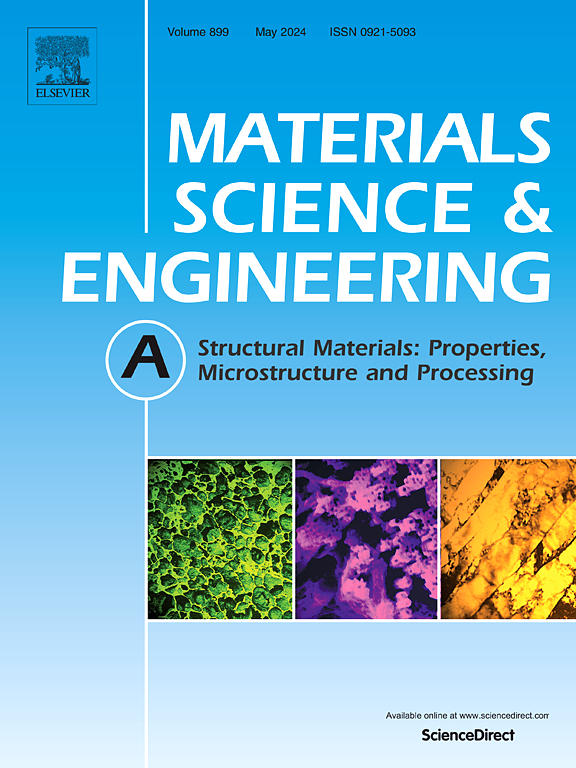Microstructural heterogeneities in additively manufactured refractory alloy C103 and their implications for room and elevated temperature mechanical behavior
IF 6.1
2区 材料科学
Q1 MATERIALS SCIENCE, MULTIDISCIPLINARY
引用次数: 0
Abstract
Considering the vast component design space enabled by fusion-based additive manufacturing (F-BAM) processes, e.g., directed energy deposition (DED), the scale-up manufacturing of Nb-alloys with F-BAM is advantageous for structural applications. However, varying thermokinetic parameters-induced microstructural heterogeneities are prevalent within the F-BAM processed alloys. Such microstructural heterogeneities can have significant implications for the room and elevated temperature mechanical behavior. While a few studies investigating F-BAM processed alloy C103 are available, none of these studies investigate the microstructural heterogeneities – including those associated with solidification growth modes and second phase particles – and the effect thereof on the mechanical behavior. To this end, we investigate the microstructurally heterogeneous regions with varying solidification growth morphologies, segregation behavior, and second phase particle attributes within the laser-DED processed alloy C103. The implications of such heterogeneous regions for room- and elevated-temperature tensile behavior and damage mechanisms are revealed. Particularly, the interface between the cellular and planar region is identified as susceptible to deformation localization. The implications of hot isostatic pressing (HIP) for the consolidation behavior, microstructural evolution, and resulting mechanical behavior are also discussed. Although the recrystallization and grain growth led to a reduced yield strength in the HIPed condition, the homogenization of microstructure alleviated the deformation localization sites, such as the planar/cellular interface within the melt pool. The homogenized microstructure alongside the enhanced consolidation upon HIP led to an enhanced elongation to failure. Findings establish microstructural design considerations in F-BAM processed Nb alloys and also facilitate design of post-processing heat treatments for achieving improved mechanical properties.
增材制造耐火合金C103的显微组织非均质性及其对室温和高温力学行为的影响
考虑到基于熔合的增材制造(F-BAM)工艺(例如定向能沉积(DED))带来的巨大组件设计空间,使用F-BAM大规模制造nb合金有利于结构应用。然而,不同的热动力学参数引起的显微组织不均匀性在F-BAM加工的合金中普遍存在。这种微观结构的非均质性对室温和高温下的力学行为具有重要的影响。虽然有一些关于F-BAM加工的C103合金的研究,但这些研究都没有研究微观组织的非均质性-包括与凝固生长模式和第二相颗粒相关的非均质性-及其对力学行为的影响。为此,我们研究了激光ded加工C103合金中具有不同凝固生长形貌、偏析行为和第二相颗粒属性的显微组织非均匀区。揭示了这种非均质区域对室温和高温拉伸行为和损伤机制的影响。特别地,元胞区域与平面区域之间的界面易受变形局部化的影响。本文还讨论了热等静压(HIP)对固结行为、微观组织演变和由此产生的力学行为的影响。虽然在HIPed条件下,再结晶和晶粒长大导致屈服强度降低,但微观组织的均匀化缓解了变形局部化部位,如熔池内的平面/胞状界面。均匀化的微观组织和强化的高温凝固导致了断裂伸长率的提高。研究结果确立了F-BAM加工Nb合金的微观组织设计考虑因素,也为设计后处理热处理以获得更好的机械性能提供了便利。
本文章由计算机程序翻译,如有差异,请以英文原文为准。
求助全文
约1分钟内获得全文
求助全文
来源期刊

Materials Science and Engineering: A
工程技术-材料科学:综合
CiteScore
11.50
自引率
15.60%
发文量
1811
审稿时长
31 days
期刊介绍:
Materials Science and Engineering A provides an international medium for the publication of theoretical and experimental studies related to the load-bearing capacity of materials as influenced by their basic properties, processing history, microstructure and operating environment. Appropriate submissions to Materials Science and Engineering A should include scientific and/or engineering factors which affect the microstructure - strength relationships of materials and report the changes to mechanical behavior.
 求助内容:
求助内容: 应助结果提醒方式:
应助结果提醒方式:


